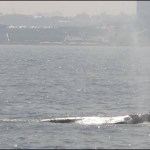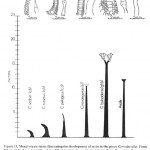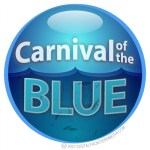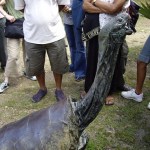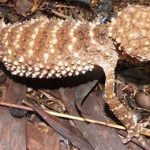Life Sciences
It's just too good not to mention. Yesterday I re-posted an old article about manatee dispersal across the Atlantic. And on the same day came news that a living Grey whale Eschrichtius robustus has been seen off Herzliya Marina, Israel, meaning that at least one living, breathing Grey whale is currently swimming around in the Mediterranean (in order to make sure that Americans pick up this article while googling: Gray whale Gray whale Gray whale). A team of experts were sent out to look at it: they verified the identification and got great photos, like this one...
As has been mentioned by…
The skeleton of Megatherium, as figured in William Buckland's Geology and Mineralogy Considered With Reference to Natural Theology.
There is something fantastically weird about giant ground sloths. Creatures from a not-too-distant past, close enough in time that their hair and hide is sometimes found in circumstances of exceptional preservation, these creatures have no living equivalent. Their arboreal cousins still live in the tropics of the western hemisphere, but they can hardly be considered proxies for the ground sloths of the Pleistocene.
The most famous of these ancient beasts was…
Last week Ben Young Landis, the 2010 editor, and I had a great first meeting about Open Lab and how we are going to do the whole thing this year. In the meantime, dig through your archives or the archives of other blogs you like and submit the best posts.
The Submission form is here. Under the fold are entries so far, as well as buttons and the bookmarklet. The instructions for submitting are here.
============================
A Blog Around The Clock: What does it mean that a nation is 'Unscientific'?
A Blog Around The Clock: My latest scientific paper: Extended Laying Interval of Ultimate…
I'm a bit of an odd bird in the world of cancer. No, it's not because I run a snarky skeptical blog that routinely deconstructs the nonsense that alt-med practitioners sprew far and wide, nor is it because I've developed a middling level of popularity that shocks me from time to time. Nor is it because I've taken on an obscure pseudonym based on a computer that looked like a Plexiglass box full of colored blinking lights from an even more obscure late 1970s British science fiction show with the low-budget asthetic of Tom Baker-era Doctor Who, although personally I sometimes wonder what it…
[It's a really busy week over here at blog headquarters, because it is data collection week. Data collection week is awesome, but it means less time for blogging. So here's a piece from the archives. I picked this one especially for Drugmonkey, because he liked it so much.]
The Harpy Eagle (Harpia harpyja) is a nasty scary-looking muppethugging monster of a carnivorous bird. Female harpies weigh 14-20 pounds, and males weigh 8.5-12 pounds. They stand between 2.9 and 3.5 feet tall. The wingspan of the harpy eagle can reach 6 feet, 7 inches. The talons - sharp claws to grasp onto its prey -…
There are 37 new articles in PLoS ONE today. As always, you should rate the articles, post notes and comments and send trackbacks when you blog about the papers. You can now also easily place articles on various social services (CiteULike, Mendeley, Connotea, Stumbleupon, Facebook and Digg) with just one click. Here are my own picks for the week - you go and look for your own favourites:
First Known Feeding Trace of the Eocene Bottom-Dwelling Fish Notogoneus osculus and Its Paleontological Significance:
The Green River Formation (early Eocene, about 42-53 Ma) at and near Fossil Butte…
Back to gekkotans: time to look at digits.
Geckos are well known for the ability of many species to cling to vertical surfaces, and even to ceilings. In fact, this is usually the one thing about geckos that everyone knows. The powers of gecko adhesion are such that geckos can support their entire weight while hanging from a single digit, they can remain stuck to leaves while exposed to 98 km/h winds, and they can also remain stuck to a surface when dead (Russell 1976). Expanded digital pads - called scansors or scansor pads - are lined on their undersides with rows of lamellae, and these…
"It is funny, but not that funny."
Eric's comment does not stop my uncontrollable giggling. My step-mother comes over to see why I'm hysterical. She agrees with Eric - it is funny, but not funny enough to explain why tears of laughter are literally coming out of my eyes.
I'm reading a passage in Michael Perry's excellent book _Coop: A Year of Poultry, Pigs and Parenting_. I gave the book to my step-mother for her birthday, and during a family visit (note blog silence) from which we returned last night, I finally read it.
Now I read a lot of the "How We Done Moved to a Farm and Made Fools…
Today, four of seven PLoS journals published new articles. I took a look and picked (under the fold) those I found interesting and/or 'bloggable'. As always, you should rate the articles, post notes and comments and send trackbacks when you blog about the papers. You can now also easily place articles on various social services (CiteULike, Mendeley, Connotea, Stumbleupon, Facebook and Digg) with just one click. Here are my own picks for the week - you go and look for your own favourites:
Mapping the Evolution of Scientific Fields:
Despite the apparent cross-disciplinary interactions among…
The discussion is interesting. Sam Harris recently and infamously proposed that, contra Hume, you can derive an 'ought' from an 'is', and that science can therefore provide reasonable guidance towards a moral life. Sean Carroll disagrees at length.
I'm afraid that so far I'm in the Carroll camp. I think Harris is following a provocative and potentially useful track, but I'm not convinced. I think he's right in some of the examples he gives: science can trivially tell you that psychopaths and violent criminals and the pathologies produced by failed states in political and economic collapse are…
The Submission form is here so you can get started. Under the fold are entries so far, as well as buttons and the bookmarklet. The instructions for submitting are here.
============================
A Blog Around The Clock: What does it mean that a nation is 'Unscientific'?
A Blog Around The Clock: My latest scientific paper: Extended Laying Interval of Ultimate Eggs of the Eastern Bluebird
A Blog Around The Clock: Evolutionary Medicine: Does reindeer have a circadian stop-watch instead of a clock?
A Meandering Scholar: Back to basics: The Evolution of a Postdoc
Anna's Bones: The Ape That…
Ahoy mates, and welcome aboard the 36th edition of the Carnival of the Blue!
The Oceans as a whole:
As many of you might know, CITES had its once-every-three-years meeting during which it decides which organisms are to be regulated and how. As Rick MacPherson explains, the overall message was simple: FU, Ocean. He takes a closer look at the CITES listing process and digs a little deeper into the "secret ballots."
Maybe CITES will take note if the world made it clear that oceans matter. There's no better time than now to take Oceana's Ocean Pledge. If you do, $1 will be donated to Oceana to…
tags: Birdbooker Report, bird books, animal books, natural history books, ecology books
Books to the ceiling,
Books to the sky,
My pile of books is a mile high.
How I love them! How I need them!
I'll have a long beard by the time I read them.
~ Arnold Lobel [1933-1987] author of many popular children's books.
The Birdbooker Report is a special weekly report of a wide variety of science, nature and behavior books that currently are, or soon will be available for purchase. This report is written by one of my Seattle birding pals and book collector, Ian "Birdbooker" Paulsen, and is edited…
Until recently the Mascarenes were home to an endemic radiation of giant tortoises, the Cylindraspis species. These were entirely separate from the better known, more 'typical' Mascarene giant tortoises grouped together in Dipsochelys or Aldabrachelys (Austin & Arnold 2001). Easily the most remarkable Cylindraspis tortoise was C. vosmaeri from Rodrigues, sometimes called the Rodrigues saddle-backed tortoise...
As you can see from these life-sized models, C. vosmaeri was a veritable giraffe (or sauropod) among tortoises: we have a good idea of its appearance in life thanks to a (very…
Once a year, Christmas Island experiences a red tide completely unlike any other in the world. The roads are blockaded as a swarm of Christmas Island Red Crabs (Gecarcoidea natalis), one hundred million strong, makes its way from the forests to the sea. This massive migration is fueled by the strongest urge an animal has: to reproduce. They must travel from their forest homes to the sea to spawn. The drive is so strong that the crabs will crawl their way onto, into and over whatever they must to reach the water's edge. So many migrate that the horde of legs, claws and carapaces can be seen…
Four out of seven PLoS journals published new articles today. Under the fold are those I personallyt found most interesting and/or 'bloggable'. As always, you should rate the articles, post notes and comments and send trackbacks when you blog about the papers. You can now also easily place articles on various social services (CiteULike, Mendeley, Connotea, Stumbleupon, Facebook and Digg) with just one click. Here are my own picks for the week - you go and look for your own favourites:
Climate Change Risks and Conservation Implications for a Threatened Small-Range Mammal Species:
Climate…
Student guest post by Raj Nair.
Multiple sclerosis (MS) is a chronic inflammatory demyelinating disease that affects the central nervous system (CNS) consisting of the brain and the spinal cord [1]. It is thought to be an autoimmune disease since individual's immune system attacks their own healthy tissues [1]. However, studies to ascertain triggering factors such as genetic, environmental, and infectious causes are still in progress [2]. So one wonders "Who is more susceptible to develop MS" Literature reveals that typically people between 20 and 50 years of age are commonly diagnosed…
More on gekkotans, and this time were going to look at various details of gekkotan anatomy. Gekkotans are, being lizards, lizard-shaped (though with the near-limbless pygopodids being snake-like). But what makes them really special is that certain parts of their bodies - in particular, their hands and feet, and often their tails - are highly specialised and mightily weird [images here - from wikipedia - show the fat-tailed eublepharid Hemitheconyx caudicinctus and the gekkonine Ptychozoon kuhli with its tessellated tail].
We'll start by looking at tails. Many gekkotans use the tail for fat…
Fossil fish from the Eocene age Green River Formation in Colorado. From Wikipedia.
I am pretty tired of Richard Dawkins putting down paleontology. In his 2004 tome The Ancestor's Tale, as well as in his latest book The Greatest Show on Earth, Dawkins felt compelled to cast the fossil record as an unnecessary bonus when it comes to demonstrating the reality of evolution. "The evidence for evolution would be entirely secure," he asserts in the latter book, "even if not a single corpse had ever fossilized." While this statement contains a crumb of truth - we have learned much about evolution…
The Submission form is here so you can get started. Under the fold are entries so far, as well as buttons and the bookmarklet. The instructions for submitting are here.
============================
A Blog Around The Clock: What does it mean that a nation is 'Unscientific'?
A Blog Around The Clock: My latest scientific paper: Extended Laying Interval of Ultimate Eggs of the Eastern Bluebird
A Blog Around The Clock: Evolutionary Medicine: Does reindeer have a circadian stop-watch instead of a clock?
A Meandering Scholar: Back to basics: The Evolution of a Postdoc
Anna's Bones: The Ape That…
